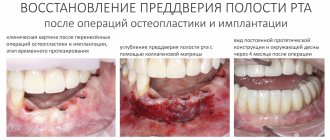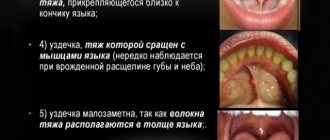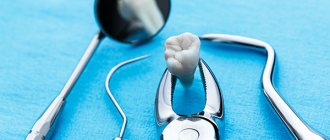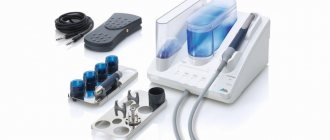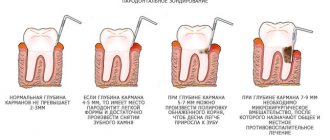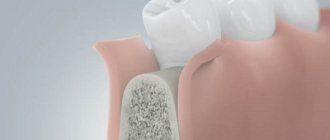What is flap surgery in dentistry?
Surgery helps eliminate the pathological process in severe stages of periodontitis, when inflammation affects not only soft tissue, but also spreads to the bone tissue surrounding the teeth. In this case, there is a real threat of premature tooth loss. The problem cannot be solved using conservative methods; surgical treatment is required.
Flap surgery is one of the methods of surgical periodontology, aimed at stabilizing periodontitis. The name of the procedure is due to the tactics of accessing the roots of teeth to clean them of infected tissue. During the operation, using vertical incisions in the gums on both sides, a gingival flap is formed above the projection of the damaged teeth, which is folded back to access the tooth roots and clean them from pathological plaque, tartar and tissues atrophied due to a long-term inflammatory process.
If necessary, to restore hard tissue, bone material is transplanted to promote the formation of one’s own bone. To improve the regeneration of mucous membranes, a fibrin membrane is installed, which contains important cellular elements and increases the local immunological status in the area of surgery. After the manipulations, the flap is sutured back.
There are cases when a person does not have enough of his gums - due to a long pathological process, recession (loss) occurs. In such a situation, our periodontist decides to use transplant material - these are the patient’s own tissues, which are taken from the hard palate or the area behind the wisdom teeth.
The use of a microscope makes the procedure
minimally invasive.
Optical magnification allows the use of micro-instruments and the finest monofilaments. This ensures neat incisions and sutures, resulting in rapid healing and excellent aesthetic results.
Levin Dmitry Valerievich Chief physician and founder of the Doctor Levin center
Flap surgery is a tooth-preserving intervention. With its help, it becomes possible to stop the inflammatory process, stabilize the situation, reverse the manifestations of periodontitis - eliminate periodontal pockets, restore periodontal tissues, reduce tooth mobility.
Oral care after flap surgery
To avoid postoperative complications, you must strictly follow the recommendations of dentists. Here are the main ones:
- Ice is applied to reduce swelling;
- to prevent an infectious or inflammatory process, anti-inflammatory and antibacterial agents are prescribed;
- Painkillers are prescribed to reduce pain. But they are not always shown, because People have different pain sensitivity thresholds;
- You cannot rinse your mouth; instead, use antiseptic baths;
- During the month you should limit physical activity, protect yourself from hypothermia or overheating;
- Diet: Avoid eating hard and irritating foods. Food should not be too hot or too cold;
- You need to brush your teeth carefully, trying not to injure the gums. The bristles of the toothbrush should be soft.
Indications for use
Periodontitis is practically asymptomatic in the initial stages of development; with timely diagnosis, conservative (non-surgical) methods are usually sufficient. A direct indication for patch surgery is progressive periodontitis in advanced forms of clinical course (stages 3 and 4), which are diagnosed by a periodontist based on the following criteria :
- the presence of deep periodontal pockets of more than 4-5 millimeters
- significant damage to the tissues of the alveolar process
- more than half of the tooth root is exposed
- severe tooth mobility
- pathological changes in gum tissue - thinning, atrophy, appearance of fibrous structures
A person himself may suspect the development of a pathological process. In advanced stages of periodontitis, the quality of life deteriorates significantly; the symptoms are disturbing:
- Bleeding gums, which appears gradually - first with strong mechanical stress, then even with slight pressure with a toothbrush
- Unpleasant and persistent odor from the mouth, which is difficult to hide by rinsing, using mouth fresheners, and a metallic taste appears in the mouth
- Teeth become very sensitive to any irritating factors, for example, cold and hot drinks, sour or salty foods
- There is a feeling of tooth mobility, which worsens over time; chewing food develops into a real problem.
- The gums become uneven, with elements of white atrophy
- Temperature periodically rises, general weakness increases
These manifestations are a reason to immediately consult a doctor. It is important not to start the process - the sooner treatment is carried out, the greater the chances of a complete cure .
How does periodontitis develop?
Periodontitis is a chronic inflammation of periodontal tissues that develops for a number of reasons. The disease can occur due to incomplete removal of plaque, which leads to infection of periodontal tissues. Possible causes also include allergic reactions to medications, trauma to periodontal tissue, bite defects and various diseases of the body that cause hormonal and metabolic disorders.
Periodontitis has 4 stages of development:
1. Initial – symptoms are absent or mild. At this stage, bad breath often appears, heavy plaque on the enamel, the color of the gums changes, and slight bleeding is observed.
2. At the second stage of periodontitis, the interdental septa decrease by 1/4 - 1/3 of the root. Symptoms become more pronounced: the formation of tartar, deformation and swelling of the gums, pain, increased interdental space, slight exposure of the root, etc. At this stage, periodontal “pockets” are filled with purulent contents, which can also be manifested by general fatigue and increased body temperature.
3. 3rd degree progressive, the root opens 1/2. There is deformation of the teeth and gums, severe bleeding, instability of the teeth, pain when chewing and pressing on the crown. Immediate treatment is required. Flap surgery on gums is recommended
.
4. The last stage of periodontitis is irreversible. Treatment is possible only with complete removal of damaged teeth followed by prosthetics.
Preparation for flap surgery
Surgical manipulations on the gums require special preparation to avoid complications during surgery and in the postoperative period.
Diagnostics
Aimed at determining the stage of periodontitis and choosing treatment tactics. The periodontist conducts:
- examination - to assess the depth of periodontal pockets and the amount of deposits on the teeth.
- Anamnesis collection To obtain information about the duration of the inflammatory process, the presence of systemic diseases of the body.
- Bakposev Sowing the contents of the gum pockets - for microflora and sensitivity to drugs.
- Tests Prescribes blood tests - general and sugar, if necessary - for the level of hormones and vitamins.
The most important and informative diagnostic method is computed tomography (CT).
A CT scan is performed to assess the degree of bone tissue destruction, depending on which the surgical tactics and the need to use bone materials and gum grafts are determined.
Complex events
In our Center, flap operations are performed only in combination with other procedures that precede surgery and provide high-quality preparation to avoid complications:
- Hygienic cleaning Removing deposits from the visible part of the teeth from plaque and tartar to prevent infection of the surgical area.
- Sanitation of the oral cavity Treatment of dental diseases (caries, pulpitis, periodontitis) to eliminate all foci of inflammation in the oral cavity.
- Splinting Stabilization of teeth with splinting structures in case of severe mobility in order to prevent their loss.
- Anti-inflammatory therapy Taking antibacterial drugs to prevent possible infectious complications.
Medvedeva Tatyana Alexandrovna
Dentist-periodontist, 6 years of experience
Specialist in the diagnosis and treatment of gum diseases. Conservative, surgical, regenerative treatment. Microsurgical operations without pain under sedation.
More about the doctor
Preparatory stage
Before prescribing an operation, the dental surgeon conducts a thorough diagnosis using visual and hardware methods. X-ray and (or) computed tomography make it possible to assess the condition of tissues, identify foci of inflammation, and develop a surgical plan. If indicated, a complete sanitation of the oral cavity is carried out: treatment of teeth and gums, a comprehensive professional cleansing procedure. If the elements of the dentition are unsteady, splinting is performed (fixing a splint on loose teeth to stabilize their position).
Stages of the procedure
The procedure is performed by a periodontist at our Center. Lasts from one to three hours.
The duration depends on the scale of the operation (in the area of one tooth or a segment of several teeth), complete or partial detachment of the flap is performed, whether bone regeneration or gum augmentation with grafts is performed.
In general, the course of the operation is as follows:
- Formation of the flap Treatment of the oral cavity with special antiseptic solutions. Making two vertical incisions from the crease to the edge of the gum and a horizontal incision along the lower edge. Formation of a periosteal flap, instrumental provision of access to the root zone.
- Root cleaning Removal of infected tissue, removal of tartar and grinding of tooth roots. If there is a clear deficiency of bone tissue, the doctor fills it with bone materials.
- Suturing After completion of all planned manipulations, the flap is returned to its original place or shifted to increase the size of the gum. When there is a deficiency of mucous tissue, gum grafts are used. Sutures are placed in the spaces between the teeth.
- Treatment The postoperative surface is carefully treated with an antiseptic, an antiseptic napkin and a periodontal bandage are applied.
After the operation, the doctor gives mandatory recommendations for oral care, which will allow you to maintain the results for many years.
After 7-10 days, the doctor removes the sutures or they dissolve on their own, which depends on the suture material used.
How is closed curettage performed?
The purpose of the operation is to remove granulations from periodontal pockets, as well as those subgingival dental deposits that could not be removed using an ultrasonic scaler.
Disadvantages of the technique: curettage is carried out blindly, there is no visual overview of the surface of the roots, periodontal pockets - because of which granulations and dental deposits partially remain in their places. Scheme of closed curettage –
Closed curettage of periodontal pockets is performed under local anesthesia. Curettage of the gums with sharp curettes is accompanied by bleeding, which further complicates visual control. At the end of the operation, the wound surface is treated with antiseptics, and a protective gum bandage is applied for several days. In Fig. 7 you can see the instruments used to perform closed curettage. Laser surgery is also an option (see video below).
Closed curettage can be more or less effective only with shallow periodontal pockets (no more than 3-4 mm), i.e. with the mildest degree of periodontitis. For moderate and severe periodontitis, closed curettage (by reducing the volume of granulations) can only temporarily improve the condition of the gums, but this improvement will only be short-term, and periodontitis will definitely progress further. In some cases, closed curettage is performed as a preparatory step before open curettage or flap surgery.
The closed curettage technique is popular in dental clinics that do not have an experienced periodontist surgeon, and therefore the operation is performed by an ordinary general dentist (periodontist). These specialists have neither the skills nor experience in performing complex surgical interventions in the oral cavity, which include open curettage and flap operations. Therefore, the worst thing that can happen to you in this situation is that you will undergo a closed curettage (although with your pocket depth, more radical techniques have long been indicated for you).
In this case, the following consequences are possible - 1) you will get a short-term, but still improvement, 2) you will not get any results from the treatment in principle, 3) closed curettage can provoke an exacerbation of periodontitis, in which case you will get suppuration from the periodontal pockets and acceleration of inflammatory bone resorption.
Closed curettage using curettes and laser –
Video 1 shows scraping of granulations from a periodontal pocket in the area of only one tooth. As you can see, this use of curettes is quite traumatic and is accompanied by bleeding. In video 2, periodontal pockets are treated using a laser. In most cases, this will also be accompanied by slight bleeding (especially if the gums are loose and inflamed).
Is it painful to have flap surgery?
The operation is completely painless as local anesthesia is provided through injections around the surgical area.
But for patients with phobias who experience an overwhelming fear of dental treatment, as well as for people with a low pain threshold, or in the case of long-term large-scale interventions, we offer the operation during sleep.
This is not general anesthesia. Ultra-short-acting sedatives are used, which are completely eliminated from the body after 30-40 minutes and do not cause adverse reactions such as nausea, dizziness and clouding of consciousness. Sedation provides absolute psycho-emotional and physical comfort, without worries or pain.
The use of sedation also has a beneficial effect on the healing rate - the pressure does not increase, and the risk of bleeding, hematomas and postoperative edema is correspondingly reduced. The body does not produce a stress hormone, which causes a response from the body in the form of decreased immunity.
Advantages of visiting our clinic
- Cooperation with us gives our clients a number of advantages:
- Service at your level.
- Individual approach and loyal attitude towards each patient.
- Diagnostics and treatment using high-precision innovative equipment. Detection of dental diseases in the early stages.
- The use of licensed medications, the reliability and effectiveness of which has been tested by time.
- Providing a full range of services. Comprehensive treatment in one clinic.
- Affordable prices, reasonable pricing policy. Possibility to pay for treatment in any convenient way.
- Painlessness and high speed of procedures.
- Anonymous treatment. We comply with the privacy policy and do not disclose personal data of our clients.
- A cozy, comfortable atmosphere in which patients forget about anxiety and nervous tension. Our treatment takes place in a friendly environment. Therefore, our regular visitors are not only adults, but also children.
Modern dental treatment is aimed not only at achieving the desired result of therapy, but also at ensuring patient comfort. Therefore, you should not delay your visit to the dentist if something is bothering you. Cast aside all fears and prejudices and provide yourself with a healthy and beautiful smile for many years.
Recovery after surgery
Gum healing takes 10-14 days. On the 4-5th day after the intervention, pain disappears and swelling decreases.
Accelerated rehabilitation
For those who want to prevent problems that are inevitable after any surgical operation, our Center provides a complex of accelerated rehabilitation:
Recommendations of the periodontist in the postoperative period
In order to preserve and consolidate the result obtained after flap surgery, it is important to strictly follow all the doctor’s recommendations, both immediately after the procedure and in the long-term period.
After operation:
- In the first 7-8 hours after surgery, you should not brush your teeth or rinse your mouth.
- After 8 hours, regular rinsing with antiseptic solutions or decoctions of anti-inflammatory medicinal plants every 4 hours is recommended.
- On the first day, apply cold to the projection area of the operated gum, from the outside, to reduce tissue swelling.
- Food should only be soft and not irritate the postoperative wound; salt, pepper, and acidic foods should be excluded.
- Visiting saunas, swimming pools and gyms is prohibited.
- Smoking after surgery may cause bleeding, so abstinence is recommended.
- Active physical activity should be limited for several weeks.
- From the beginning of the 2-3 days of the postoperative period, you can begin to carefully brush your teeth, but only with a soft brush using a desensitizing paste.
- In case of severe pain, you can take analgesic drugs taking into account the recommended dose and frequency of use.
- To prevent the development of postoperative complications, the doctor prescribes a course of antibacterial drugs for 5-7 days.
Such easy-to-follow recommendations will help you avoid various complications and consolidate the results obtained.
To avoid relapses of periodontitis, it is important to avoid accumulations of subgingival deposits, so visiting a doctor every 3-6 months for professional oral hygiene and monitoring the situation is strictly necessary!
It is important not to neglect the recommendations in order to avoid complications. You will be required to be highly involved and motivated, to follow all the doctor’s recommendations for oral care.
Recommendations for postoperative care
The effectiveness of flap surgery can be judged after the difficulties of the postoperative period have been overcome.
Complications can nullify all the efforts of the surgeon. Home oral care is of great importance for a successful outcome. To avoid complications, the patient must strictly adhere to the recommendations and instructions given by the doctor, and if alarming symptoms occur, immediately contact the treating dental surgeon. What should alert you: increased body temperature, swelling of the gums, pain in the oral cavity. Expert advice:
- Do not remove the tampon placed by the doctor for 4 hours. During this same period, it is forbidden to eat and drink;
- It is not recommended to brush your teeth, rinse your mouth and smoke for 24 hours after surgery;
- you need to apply cold to the outer surface of the cheek from the side of the surgical wound;
- You should take a pain reliever if pain occurs;
- it is necessary to undergo a course of antibacterial therapy by drinking antibiotics prescribed by the doctor;
- You should regularly rinse your mouth with an antiseptic solution;
- Before the sutures are removed, physical activity, including physical education, should not be allowed;
- It is prohibited to visit the solarium, bathhouse, sauna, beach;
- food should be soft and lukewarm, in the first days – pureed.
The dental network offers services for performing flap operations. Dental surgeons are highly qualified and improve their skills in leading dental clinics in Russia and Europe. The level of services provided meets international standards, and there is a system of family and cumulative discounts.
Branches of our orthodontic center are located in Moscow within walking distance from the metro:
- Art. Alekseevskaya (VDNKh district, etc. Mira), address: st. 3rd Mytishchiskaya house 3, building 2;
- Art. Shelepikha, address: Shelepikhinskaya embankment, address: building 34, building 1.
You can trust our doctors with your health. We are waiting for you every day, sign up and come for an appointment!
Modern dental surgery
When hearing the word “surgeon”, almost every patient experiences fear and imagines some kind of painful, bloody procedures, so they are extremely reluctant to undergo treatment. In fact, modern medicine allows any intervention to be carried out absolutely painlessly, under anesthesia.
In addition, today there are a considerable number of minimally invasive atraumatic techniques that can speed up the healing process and reduce the discomfort caused to the patient during the rehabilitation period to a minimum. For example, a new branch of dentistry - laser medicine - makes it possible to carry out complex extractions and interventions almost bloodlessly, without injuring surrounding tissues and thereby significantly accelerating healing after surgery.
Therefore, patients need to be afraid not of the intervention itself, but of the consequences of not treating it: ignoring a problem that can and should be solved surgically will lead to the development of serious complications in the future and will have an extremely adverse effect on the overall health of the body.
The high level of development of modern dental surgery makes operations on teeth and jaws effective and safe for the patient.

